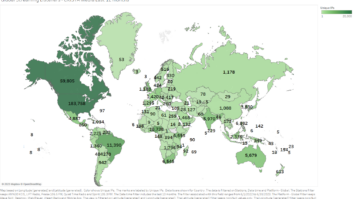The author is manager of National Institute of Standards and Technology radio stations WWV/WWVH/WWVB.
While radio station WWVB may be familiar to readers of this publication, most people would not recognize those call letters. However, if you say you have an “atomic clock” hanging on the wall of your house, most everyone would know what you meant.
Of course it is not a real atomic clock, but a radio-controlled device that receives the WWVB signal and corrects itself nightly when the 60 kHz signal propagates the best.

In July 1956 the National Bureau of Standards started radio station KK2XEI in Boulder, Colo. It was a 2 kW transmitter sending a 60 kHz signal into the summer sky. Even though the effective radiated power was less than 2 watts, the signal was received and monitored at Harvard University in Massachusetts.
This experiment showed that the frequency error due to the Doppler shift induced by the ionosphere was small. This was the forerunner of the WWVB broadcast.
In April 1960 another experiment was conducted in the foothills of the mountains west of Boulder. A valley-span antenna 3,400 feet long was strung near the old mining town of Sunset. The signal was broadcast with less than 15 watts of power, yet it was consistently observed in New Zealand.
Results from the Sunset experiment provided a much better understanding of the ionosphere and the study of whistlers, hiss, the dawn chorus and “sferics.”
This set the stage for the WWVB radio station.
Time’s top hat
Construction began in 1962 on a site north of Ft. Collins, Colo., near the small town of Wellington. The 390-acre site was chosen in part for its high ground conductivity, a result of the high alkalinity of the soil.
On July 5, 1963, WWVB began broadcasting a 7 kW signal at 60 kHz. In August of that year, its sister station, WWVL, began broadcasting a 500 W signal at 20 kHz. On July 1, 1965, WWVB added a time code to the broadcast.
The binary-coded decimal (BCD) time code transmitted 1 bit per second by shifting the power of the carrier by 10 dB. The format is explained in the accompanying graphic.
Over the next few years, improvements were made to increase the power up to approximately 13 kW, and it remained there until the late 1990s. In 1972, the WWVL broadcast was terminated and its antenna became the rarely used WWVB backup antenna.
Each antenna is a top-loaded dipole consisting of four 122 meter (400-foot) towers arranged in a diamond shape. Suspended between the four towers is a system of aluminum cables called a capacitance hat or “top hat.” The top hat is electrically isolated from the towers, but connected to a down-lead at the center of the diamond. The down-lead is the radiating element emanating from a helix house at ground level and also at the center of the diamond.
The wavelength of a 60 kHz signal is nearly 5,000 m (more than 3 miles), so the length of the radiating element plus the top hat is much less than a quarter wavelength. Therefore, the top hat is inherently capacitive and a large inductor is added in the helix house to cancel the capacitance of the short antenna. A variometer, or variable inductor, is also included in the helix house to tune the antenna, which is especially useful during wind and ice loading.
In 1997, work began to improve the WWVB broadcast. More powerful transmitters (FRT-72) were acquired from U.S. Navy surplus in Virginia, Scotland and Iceland. Extended tuning variometers were acquired from the decommissioned Navy low-frequency station NSS in Annapolis, Md.
The WWVB broadcast was kept on the air during these upgrades by use of the old WWVL antenna. When the upgrades were complete on the WWVB side, the WWVL side was upgraded and they were combined with WWVB into a dual broadcast system. Broadcasting from both antennas, the WWVB signal was boosted to 50 kW of effective radiated power beginning in 1999.
This increase in power created an explosion of new commercial radio-controlled products, more than a million of which are sold each year.
Another station?
Despite the overall quality and reliability of these products, there are times and locations at which the WWVB signal is not well received or decoded properly.
This is due to distance from the transmitter and also interference (added noise) to the signal caused by nearby radiating sources such as computer monitors or power transformers. To help improve this situation, the transmitted power was increased about five years ago to 70 kW and the modulation depth was increased from 10 dB to 17 dB. This helped, but has not solved the inherent problem of a poor signal-to-noise ratio at the receiver in the far field. New approaches were needed.
The most obvious solution was to build another time signal station on the East Coast that operated at a different frequency.
Several sites have been investigated including Greenbury Point in Annapolis; the Voice of America site in Greenville, N.C.; and some of the retired Loran-C sites.

Funding for this opportunity was made possible with the American Recovery and Reinvestment Act. The stimulus money was allocated for a station to be built at the Redstone Arsenal in Huntsville, Ala. After much negotiation and investigation, NASA determined that they did not want a large low-frequency station so close to the Marshall Space Flight Center, also located on the arsenal. NASA was concerned that such a large amount of radiated power would interfere with their operations.
Unfortunately, after all of these negotiations, time had run out for spending the ARRA money, so the funds had to be returned; now we are back to looking for other ways to improve our service.
Upgrade ideas
A possibility now being investigated is to upgrade the existing WWVB site further, by either building an antenna for a new broadcast frequency or splitting the antennas into two separate entities, as was done in the days of WWVL.
The effect of broadcasting on two frequencies from the same location improves the chances of receiving at least one of the signals because the transmission nulls are related to frequency and therefore should occur in different locations. Also, interference may be affecting only one frequency at a given location. A receiver would need to determine which signal is strongest or more readable. This is already the case for radio-controlled devices in Japan receiving signals from radio station JJY on either 40 kHz or 60 kHz.
Another idea being actively investigated is to add phase modulation to the existing WWVB signal while leaving the AM BCD code intact. This would allow all existing devices to continue to work, but allow a new generation of radio-controlled clocks to be developed. These new devices would have greater processing gain and therefore be capable of reading the time code with a lower signal-to-noise ratio.
These kinds of systematic, continuous improvement initiatives support the NIST goal of providing a reliable time source that can be received everywhere in the continental United States (and hopefully including Alaska and Hawaii).
We envision that this will continue to go beyond clocks and watches and will become ubiquitous in consumer appliances. DVD players or microwave ovens will no longer blink 12:00 after a power outage. It will no longer be necessary to adjust any clocks when a Daylight Saving Time change occurs. Soon, accurate time will be displayed everywhere and we will have lost one more excuse for being late.
I invite and encourage Radio World readers to participate in a survey to help improve our existing services and to suggest new ones. You’ll find it at http://tf.nist.gov/survey. Also you can learn more about the Time and Frequency Division of NIST at nist.gov/pml/div688/.
Comment on this or any article. Write to [email protected].












